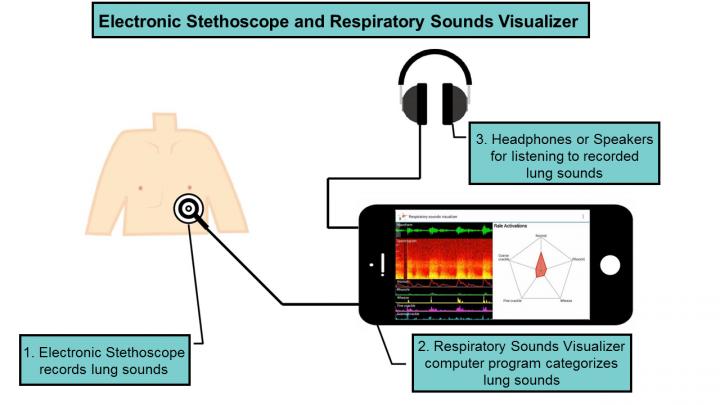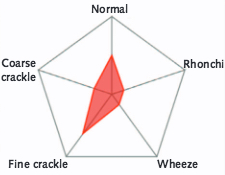New electronic stethoscope and app diagnose lung conditions
February 24, 2016

1. Electronic stethoscope records patient’s breathing. Lung sounds are sent to a phone or tablet and analyzed by an app. 3. Medical professionals can listen and see the results in real time from any location to diagnose the patient. (credit: Hiroshima University)
The traditional stethoscope has just been superseded by an electronic stethoscope and an app called Respiratory Sounds Visualizer, which can automatically classify lung sounds into five common diagnostic categories.* The system was developed by three physician researchers at Hiroshima University and Fukushima Medical University in collaboration with Pioneer Corporation.
The respiratory specialist doctors recorded and classified lung sounds of 878 patients, then turned these diagnoses into templates to create a mathematical formula that evaluates the length, frequency, and intensity of lung sounds. The resulting app can recognize the sound patterns consistent with five different respiratory diagnoses.
How the Respiratory Sounds Visualizer app works

Based on an analysis of the characteristics of respiratory sounds, the Respiratory Sounds Visualizer app generates this diagnostic chart. The total area in red represents the overall volume of sound, and the proportion of red around each line from the center to each vertex represents the proportion of the overall sound that each respiratory sound contributes. (credit: Shinichiro Ohshimo et al./Annals of Internal Medicine)
The app analyzes the lung sounds and maps them on a five-sided chart. Each of the five axes represents one of the five types of lung sounds. Doctors and patients can see the likely diagnosis based on the length of the axis covered in red.
A doctor working in less-than-ideal circumstances, such as a noisy emergency room or field hospital, could rely on the computer program to “hear” what they might otherwise miss, and the new system could help student doctors learn.
The results from the computer program are simple to interpret and can be saved and shared electronically. In the future, this convenience may allow patients to track and record their own lung function during chronic conditions, like chronic obstructive pulmonary disease (COPD) or cystic fibrosis.
“We plan to use the electronic stethoscope and Respiratory Sounds Visualizer with our own patients after further improving [the mathematical calculations]. We will also release the computer program as a downloadable application to the public in the near future,” said Shinichiro Ohshimo, MD, PhD, an emergency physician in the Department of Emergency and Critical Care Medicine at Hiroshima University Hospital and one of the researchers involved in developing the technology.
* Despite advances in technology, respiratory physiology still depends primarily on chest auscultation, [which is] subjective and requires sufficient training. In addition, identification of the five respiratory sounds specified by the International Lung Sounds Association is difficult because their frequencies overlap:The frequency of normal respiratory sound is 100 to 1000 Hz, wheeze is 100 to 5000 Hz, rhonchus is 150 Hz, coarse crackle is 350 Hz, and fine crackle is 650 Hz. — Shinichiro Ohshimo et al./Annals of Internal Medicine.